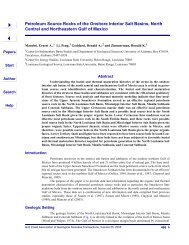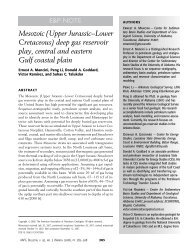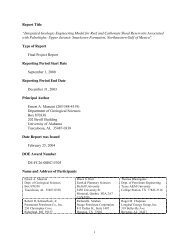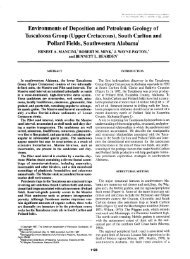Part 4 - Berg - Hughes Center
Part 4 - Berg - Hughes Center
Part 4 - Berg - Hughes Center
Create successful ePaper yourself
Turn your PDF publications into a flip-book with our unique Google optimized e-Paper software.
RESULTS AND DISCUSSION<br />
Geologic History<br />
The geologic history of the North Louisiana Salt Basin is directly linked to the<br />
evolution of the Gulf of Mexico basin (Wood and Walper, 1974). The Gulf of Mexico is<br />
a divergent margin basin dominated by extensional tectonics and wrench faulting (Pilger,<br />
1981; Miller, 1982; Klitgord et al., 1984; Van Siclen, 1984; Pindell, 1985; Salvador,<br />
1987; Winker and Buffler, 1988; Buffler, 1991). The origin of the Gulf of Mexico basin<br />
consists of phases of crustal extension and thinning, of rifting and sea-floor spreading,<br />
and of thermal subsidence (Nunn, 1984).<br />
Sawyer et al. (1991) proposed the following as a model for the evolution of the Gulf<br />
of Mexico and related onshore interior salt basins based on the distribution of crust type.<br />
A Late Triassic-Early Jurassic early rifting phase is typified by half-grabens bounded by<br />
listric normal faults and filled with nonmarine red bed sediments and volcanics. A Middle<br />
Jurassic phase of rifting, crustal attenuation and the formation of transitional crust is<br />
characterized by a pattern of alternating basement paleotopographic highs and lows and<br />
the accumulation of thick salt deposits. A Late Jurassic phase of sea-floor spreading and<br />
oceanic crust formation is typified by an extensive marine transgression as a result of<br />
crustal cooling and subsidence. Subsidence continued into the Early Cretaceous and a<br />
carbonate shelf margin developed along the tectonic hinge zone of differential subsidence<br />
between thick transitional crust and thin transitional crust.<br />
This depositional pattern was interrupted by a time of igneous activity and global<br />
sea-level fall during the Late Cretaceous (mid-Cenomanian) that produced a major drop<br />
in sea level and resulted in the exposure of the shallow Cretaceous platform margin that<br />
432













